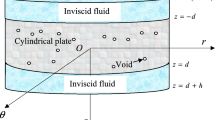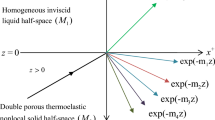Abstract
Poroelasticity theory has become an effective and accurate approach to analyzing the intricate mechanical behavior of a porous medium containing two immiscible fluids, a system encountered in many subsurface engineering applications. However, the resulting partial differential equations in the theory intrinsically take on a coupled form in the terms pertinent to inertial drag, viscous damping, and applied stress, making it difficult to obtain closed-form, steady-state analytical solutions to boundary-value problems except in special cases. In the present paper, we demonstrate that, for dilatational wave excitations, these partial differential equations can be decoupled analytically into three Helmholtz equations featuring complex-valued, frequency-dependent normal coordinates that correspond physically to three independent modes of dilatational wave motion. The normal coordinates in turn can be expressed in the frequency domain as three different linear combinations of the solid dilatation and the linearized increment of fluid content for each pore fluid, or equivalently, as three different linear combinations of total dilatational stress and two pore fluid pressures. These representations are applicable to strain-controlled and stress-prescribed boundary conditions, respectively. Numerical calculations confirm that the phase speed and attenuation coefficient of the three dilatational waves represented by the Helmholtz equations are exactly identical to those obtained previously by numerical solution of the dispersion relations for dilatational wave excitation of a porous medium containing two immiscible fluids. Thus, dilatational wave motions in unsaturated porous media subject to suitable boundary conditions can now be accurately modeled analytically.
Similar content being viewed by others
References
Johnson DL (1986) Recent developments in the acoustic properties of porous media. In: Sette D (eds) Proceedings of the international school of physics Enrico Fermi Course XCIII, Frontiers in physical acoustics. North Holland, Amsterdam, pp 255–290
Finol A, Farouq Ali SM (1975) Numerical simulation of oil production with simultaneous ground subsidence. J Soc Petrol Eng 259: 411–422
Kosloff D, Scott RF, Scranton M (1980) Finite element simulation of Wilmington oil field subsidence: I. linear modeling. Tectonophys 65: 339–368. doi:10.1016/0040-1951(80)90082-7
Corapcioglu MY, Bear J (1983) A mathematical model for regional land subsidence due to pumping: 3 integrated equations for a phreatic aquifers. Water Resour Res 19: 895–908. doi:10.1029/WR019i004p00895
Beresnev IA, Johnson PA (1994) Elastic-wave stimulation of oil production: a review of methods and results. Geophysics 59(6): 1000–1017. doi:10.1190/1.1443645
Spanos T, Davidson B, Dusseault M, Shand D, Samaroo M (2003) Pressure pulsing at the reservoir scale: a new IOR approach. J Can Petrol Technol 42(2): 16–28
Montgomery DR, Manga M (2003) Steamflow and water well response to earthquakes. Science 300: 2047–2049. doi:10.1126/science.1082980
Gambolati G, Teatini P, Baú D, Ferronato M (2000) Importance of poroelastic coupling in dynamically active aquifers of the Po river basin, Italy. Water Resour Res 36(9): 2443–2459. doi:10.1029/2000WR900127
Wang HF (2000) Theory of linear poroelasticity with applications to geomechanics and hydrogeology. Princeton University Press, Princeton
Li X, Zhong L, Pyrak-Nolte LJ (2001) Physics of partially saturated porous media: residual saturation and seismic-wave propagation. Annu Rev Earth Planet Sci 29: 419–460. doi:10.1146/annurev.earth.29.1.419
Cosenza P, Ghoreychi M, de Marsily G, Vasseur G, Violette S (2002) Theoretical prediction of poroelastic properties of argillaceous rocks from in situ specific storage coefficient. Water Resour Res 38(10): 1207. doi:10.1029/2001WR001201
Coussy O (2004) Poromechanics. Wiley, Chichester
Lo WC, Sposito G, Majer E (2005) Wave propagation through elastic porous media containing two immiscible fluids. Water Resour Res 41: W02025. doi:10.1029/2004WR003162
Biot MA (1941) General theory of three-dimensional consolidation. J Appl Phys 12: 155–164. doi:10.1063/1.1712886
Biot MA (1956) Theory of propagation of elastic waves in a fluid-saturated porous solid, I. Low-frequency range, II. Higher frequency range. J Acoust Soc Am 28(2): 168–191. doi:10.1121/1.1908239
Biot MA (1962) Mechanics of deformation and acoustic propagation in porous media. J Appl Phys 33(4): 1482–1498. doi:10.1063/1.1728759
Drew DA, Passman SL (1999) Theory of multicomponent fluids. Springer-Verlag, New York
Dullien FLA (1992) Porous media: fluid transport and pore structure. Academic Press, San Diego
Brutsaert W (1964) The propagation of elastic waves in unconsolidated unsaturated granular mediums. J Geophys Res 69(2): 243–257. doi:10.1029/JZ069i002p00243
Brutsaert W, Luthin JM (1964) The velocity of sound in soils near the surface as a function of the moisture content. J Geophys Res 69(4): 643–652. doi:10.1029/JZ069i004p00643
Garg SK, Nayfeh AH (1986) Compressional wave propagation in liquid and/or gas saturated elastic porous media. J Appl Phys 60(9): 3045–3055. doi:10.1063/1.337760
Tuncay K, Corapcioglu MY (1997) Wave propagation in poroelastic media saturated by two fluids. J Appl Mech 64(2): 313–320. doi:10.1115/1.2787309
Wei C, Muraleetharan KK (2002) A continuum theory of porous media saturated by multiple immiscible fluids: I. Linear poroelasticity. Int J Eng Sci 40: 1807–1833. doi:10.1016/S0020-7225(02)00068-X
Berryman JG, Thigpen L, Chin RCY (1988) Bulk elastic wave propagation in partially saturated porous solids. J Acoust Soc Am 84(1): 360–373. doi:10.1121/1.396938
Santos JE, Corbero JM, Douglas J (1990) Static and dynamic behavior of a porous solid saturated by a two-phase fluid. J Acoust Soc Am 87(4): 1428–1438. doi:10.1121/1.399439
Dutta NC, Ode H (1979) Attenuation and dispersion of compressional waves in fluid-filled porous rocks with partial gas saturation (White model)—Part I: Biot theory. Geophysics 11: 1777–1788. doi:10.1190/1.1440938
Berryman JG (1983) Dispersion of extensional waves in fluid-saturated porous cylinders at ultrasonic frequencies. J Acoust Soc Am 74(6): 1805–1812. doi:10.1121/1.390266
Chandler RN, Johnson DL (1981) The equivalence of quasistatic flow in fluid-saturated porous media and Biot’s slow wave in the limit of zero frequency. J Appl Phys 52(5): 3391–3395. doi:10.1063/1.329164
Lo WC, Sposito G, Majer E (2002) Immiscible two-phase fluid flows in deformable porous media. Adv Water Resour 25(8–12): 1105–1117
Lo WC, Sposito G, Majer E (2006) Low-frequency dilatational wave propagation through fully-saturated poroelastic media. Adv Water Resour 29(3): 408–416. doi:10.1016/j.advwatres.2005.05.012
Lo WC (2006) Decoupling of the coupled poroelastic equations for quasistatic flow in deformable porous media containing two immiscible fluids. Adv Water Resour 29(12): 1893–1900. doi:10.1016/j.advwatres.2006.01.002
Lo WC, Sposito G, Majer E (2007) Low-frequency dilatational wave propagation through unsaturated porous media containing two immiscible fluids. Transp Porous Media 68: 91–105. doi:10.1007/s11242-006-9059-2
de la Cruz V, Spanos TJT (1985) Seismic wave propagation in a porous medium. Geophysics 50: 1556–1565. doi:10.1190/1.1441846
Pride SR, Gangi AF, Morgan FD (1992) Deriving the equations of motion for porous isotropic media. J Acoust Soc Am 92(6): 3278–3290. doi:10.1121/1.404178
Maas C (1986) The use of matrix differential calculus in problems of multiple-aquifer flow. J Hydrol (Amst) 88: 43–67. doi:10.1016/0022-1694(86)90196-4
van Genuchten MT (1980) A closed-form equation for predicting the hydraulic conductivity of unsaturated soils. Soil Sci Soc Am J 44(5): 892–898
Mualem Y (1976) A new model for predicting the hydraulic conductivity of unsaturated porous media. Water Resour Res 12(3): 513–522. doi:10.1029/WR012i003p00513
Das BM (1993) Principles of soil dynamics. PWS-Kent, Boston
Bishop AW (1959) The principle of effective stress. Teknisk Ukeblad 39: 859–863
Bear J, Bachmat Y (1991) Introduction to modeling of transport phenomena in porous media. Kluwer, Netherlands
Whitaker S (1973) Transport equations for multiphase system. Chem Eng Sci 28(1): 139–147. doi:10.1016/0009-2509(73)85094-8
Biot MA, Willis DG (1957) The elastic coefficients of the theory of consolidation. J Appl Mech 24: 594–601
Gray WG (1983) General conservation equations for multi-phase systems: 4. Constitutive theory including phase change. Adv Water Resour 6: 130–140. doi:10.1016/0309-1708(83)90025-8
Stoll RD (1974) Acoustic waves in saturated sediments. In: Hampton L (eds) Physics of sound in marine sediments. Plenum, New York, pp 19–39
Berryman JG (1980) Confirmation of Biot’s theory. Appl Phys Lett 37(4): 382–384. doi:10.1063/1.91951
Johnson DL, Plona TJ, Scala C, Pasierb F, Kojima H (1982) Tortuosity and acoustic slow waves. Phys Rev Lett 49(25): 1840–1844. doi:10.1103/PhysRevLett.49.1840
Author information
Authors and Affiliations
Corresponding author
Rights and permissions
About this article
Cite this article
Lo, WC., Sposito, G. & Majer, E. Analytical decoupling of poroelasticity equations for acoustic-wave propagation and attenuation in a porous medium containing two immiscible fluids. J Eng Math 64, 219–235 (2009). https://doi.org/10.1007/s10665-008-9254-y
Received:
Accepted:
Published:
Issue Date:
DOI: https://doi.org/10.1007/s10665-008-9254-y




